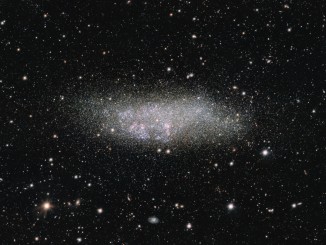
“At that speed, you could travel from Earth to the Moon in 5 minutes,” Magnier commented.
The team showed that unlike the half-dozen other known escaping stars, this compact star was ejected from an extremely tight binary by a thermonuclear supernova explosion. These results were published in the March 6th issue of the journal Science.
Stars like the Sun are bound to our Galaxy by its gravity and orbit its centre at relatively moderate velocities, tens to a few hundreds of kilometres per second. Only a few so-called hypervelocity stars are known that travel so fast that they are unbound. A close encounter with the supermassive black hole at the centre of the Milky Way is usually considered the most plausible mechanism for enabling these stars to escape from the Galaxy.
Stephan Geier (European Southern Observatory, Garching, Germany) led the team that observed the known high-velocity star, US 708, with the Echellette Spectrograph and Imager on the Keck II telescope to measure its distance and radial velocity component, that is, how fast it is moving away from us. By carefully combining position measurements from digital archives with newer positions measured from images taken during the Pan-STARRS1 survey, they were also able to derive the tangential component of the star’s velocity, or how fast it is moving perpendicular to us.
“By observing the sky repeatedly over several years, the Pan-STARRS1 survey, let us make a movie of the motions of the stars in the sky. That enables us to study the behaviors of extremely rare and weird stars like US 708,” Magnier explained.
By putting all the measurements together, they determined the total velocity of the star is 1,200 kilometres per second, much higher than the velocities of the other known stars in our Galaxy. More importantly, the trajectory of US 708 allows them to rule out the galactic centre, and therefore, its supermassive black hole, as the possible cause of US 708’s extreme velocity.
US 708 has additional peculiar properties that are in marked contrast to other hypervelocity stars: it is a rapidly rotating, compact helium star that probably formed as a result of interaction with a close companion. Helium stars are the remnant of a formerly massive star that has lost its hydrogen envelope.
Animation of the mass-transfer phase to a white dwarf followed by a double-detonation supernova that leads to the ejection of US 708 from the Galaxy. Image credit: NASA, ESA and P. Ruiz-Lapuente, cut and coloured by S. Geier
Thus, US 708 could have originally been part of an ultracompact binary system in which it transferred helium to a massive white dwarf companion, ultimately triggering a thermonuclear explosion known as a type Ia supernova. As a result of this explosion, the surviving companion, US 708, was violently ejected from the disrupted binary, and is now travelling at an extremely high velocity.
These results provide observational evidence that there is a link between helium stars and thermonuclear supernovae, and are a step toward understanding the progenitor systems of these mysterious explosions.



